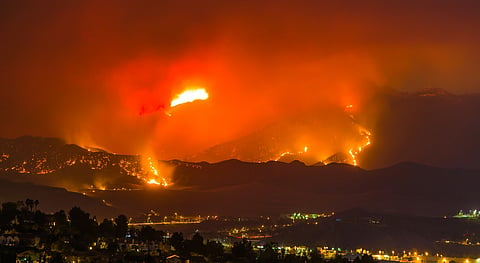

Smoke emissions from wildfires resulted in more than 40,000 excess annual deaths in the United States in the past decade, a new study has found.
Researchers from Stanford University, publishing their findings in the journal Nature, estimated that an additional 41,380 additional deaths were recorded between 2011 and 2020 due to smoke emitted from wildfires in Canada and the western United States. They warned that rising temperatures could worsen the crisis, increasing deaths by over 70 per cent by 2050.
The study noted that though wildfires are not a new phenomenon in the western US, warmer and drier conditions are exacerbating the crisis by fuelling bigger blazes that are more frequent and sustain longer as compared to previous decades.
Smoke from these wildfires impacts millions of Americans and no community is safe from the impacts of smoke exposure. Scientists said the health impacts are far higher than they previously estimated.
The harmful mix of complex chemicals entering the respiratory systems of humans results in deaths from wildfire smoke. Wildfires can expose large populations to toxic pollutants that can linger in the atmosphere for weeks, leading to deaths in three years post initial exposure, the study said.
With respect to wildfire smoke pollution, researchers often focus on fine particulate matter identified as PM2.5 that enter the lungs and bloodstream. The researchers said though impacts of the PM2.5 from other sources are studied, less information is available on the health effects of the same from wildfire smoke as a source.
However, a recent study from February this year pointed out that smoke originating from wildfires that burned structures had higher concentrations of copper, lead, zinc, and nickel relative to smoke from fires that did not burn structures.
With a business-as-usual scenario, global warming at the current rate could add up to 30,000 additional deaths per year by 2050, the scientists said, adding that climate-driven fire activity would increase and generate more smoke pollution across North America.
Senior study author and professor of environmental social sciences at the Stanford Doerr School of Sustainability, Marshall Burke said in a press statement, “Our paper puts some numbers on what that change in exposure means for health outcomes, both now and in the future as the climate warms.”
The scientists said if calculated in monetary terms, the deaths attributable to wildfire smoke could cost $608 billion per year by 2050 under the current warming scenario where global temperatures are expected to peak up to 2 degrees Celsius, compared to pre-industrial levels.
This estimated toll overrides current estimates of economic loss from combined climate-driven damages — temperature-related deaths, storm damage and agricultural losses.
Lead author of the study and an assistant professor at Stony Brook University, Minghao Qiu, said, “There are larger increases on the West Coast, but there’s also long-range transport of wildfire smoke across the country, including massive recent smoke events in the Eastern and Midwestern U.S. from Canadian fires.”
The authors collated county level data from all US recorded deaths between 2006 and 2019 with measurements of ground-level smoke emissions, wind variation and transportation of airborne particulate matter. They took assistance from machine learning to project changes in future wildfire emission changes and how emissions changes in one area would impact concentrations in another.
Comparing the changes to historical mortality and using global climate models, they found that health impacts would worsen and result in excess deaths owing to PM2.5 exposure.
The largest projected increases in annual smoke exposure deaths occur in California with 5,060 additional deaths, followed by New York at 1,810 deaths and Washington with 1,730 deaths. Texas and Pennsylvania were estimated to record 1,700 and 1,600 excess deaths respectively.
The researchers shared concerns that even if the world drastically cuts emissions to stabilise temperatures below 2 degrees Celsius by 2100, smoke pollution attributed to climate-driven wildfires would still contribute to more than 60,000 annually by mid-century.
Qui said in the statement, “If you look at the leading climate impact assessment tools that are used to inform policy, none of them incorporate how changes in climate could influence wildfire smoke and related human mortality.”
“Our study shows climate models are missing a huge part of the climate impacts in the U.S. — it’s like leaving the main character out of a movie,” Qui added.